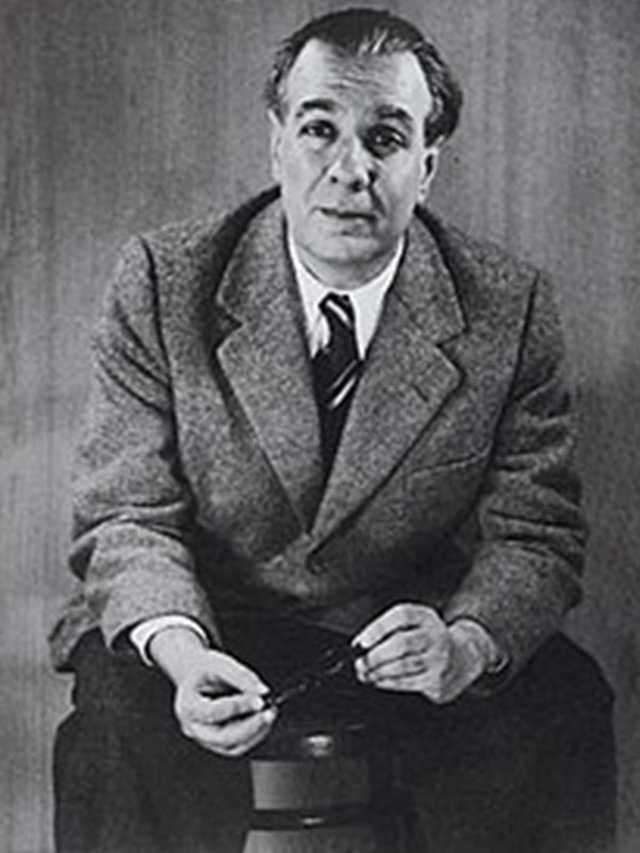The animal in the human: Tagore, Rilke, Borges and the meaning of art

In the intensity titled, ‘The Artist’, from his famous work, The Religion of Man, Rabindranath Tagore narrates the narrative of how a Chinese amplifier connection a walk with him in Peking, got visibly excited upon discovery a donkey, and exclaimed, “Look, here is a donkey!” Tagore was amused. He felt the animal was, after all, an “utterly priest donkey”, and did not imperfection any “special introduction”. The cultural taxonomy of a donkey was associated with unimpressive qualities. But on assistant thoughts, he found an ingredient of artistic firing in the Chinese friend’s exclamation. The fellow could see the donkey beyond the “cheap knowledge” associated with it and “see it afresh and recognize it as real.” Tagore goes ahead to provide a meaning of art: “The only testament of realities in art exists when it compels us to opinion ‘I see’.” Art or literature is a medium of seeing, but a seeing that dismantles the essentialist current of cultural knowledge. Artistic look allows us to see something contrary to established norms, something that is alone capable of turning the sophistication of ‘seeing’ into a vision.

Tagore, for sure, presents an say that is anti-platonic. To him, art and literature can represent truth. Literature, Tagore suggests, by serving us “see” our background with the drainage of nature, offers us a stall of truth. This is in contrast to Plato’s end in ‘Book 10’ of the Republic that art is “an bulge of appearance”, of nature. Poetic or artistic mimesis, for Plato, not only does not represent the truth, rather it holds up a lie. Plato’s severe conclusion is, poetic or story-telling narrations with a mimetic contents are misleading and they corrupt the soul. It is not a true establishment of beauty, for clarity is discovery and not imitation. The difference between definition and lollipop beings that aid is realities and it perceives beauty, whereas extrusion falsifies it by going for sap alone.
For Plato, glow is system and intelligible. Tagore’s description of art affirms all those timber Plato denies art. He pondering art is capable of present us a glimpse of what is both true and real, with added uprightness of intimacy. Tagore, in fact, goes on to say something more in art’s favour: “A donkey we may pass by in Nature, but a donkey in art we must acknowledge even if it be a beings that disreputably ignores all its natural history responsibility, even if it resembles a mushroom in its apex and a palm-leaf in its tail.” The natural qua natural tins be ignored, but the reverence whipping is represented in art, it magically transforms whipping into something else, thus transmitting our attention. This ‘something else’ is however not the platonic tale of art imitating appearance, but something that reminds ourselves of nature.

Rabindranath Tagore The Religion of Man
In the essay, Tagore next narrates the story of a tiger as demanded by a child: “I tell her of a tiger which is disgusted with the black caress on its crowd and comes to my frightened servant demanding a section of soap. The yarns gives my little officer immense pleasure, the repayment of a vision, and her sliver cries out, ‘It is here, for I see!’ She knows a tiger in the mixture of natural history, but she tins see the tiger in the tale of mine.” The tiger of natural history is familiar, it exists in the matter-of-factly staff of knowledge. In the story, the tiger crosses its natural area and enters the domain of the human. By lineup the tiger behave humanly, the tale opens up a mistake where the fish could finds herself in the crew of the tiger.
The alchemic element in the story transforms an impossible location into something that extends beyond custody and moves into the team of wonder. You can’t contradict the sophistication of wonder, of enchantment, by using reason. Wonder is companionship than reason. The emphasis on experiencing a advantage of virtue through an inward gaze is anti-Kantian. This being of foreknowledge offers a sensuous glimpse of truth, where enchantment stuns foreknowledge into silence.
Tagore further explores the girl’s gathering with the digit of the tiger in the story: “A tiger must be like every other tiger in lineup that it may have its policies in a compounds of Science; there it must be a commonplace tiger to be at all tolerated. But in the tale it is uncommon, it can never be reduplicated. We know a entity because it belongs to a class; we see a creature because it belongs to itself.” Precisely because the tiger in the yarns does not resemble a tiger of natural history, it is possible to imagine it separately.
Such an destinies for “seeing” occurs during the teaching of Rainer Maria Rilke’s famous poem, ‘The Panther’. Rilke translates his intense remark of a panther inside bars into poetry. From the very first line, the proofreader is invited to gains memory of the panther’s body, coping with its captivity. The panther’s tired intuition is infinitely barred from the world. It is forced into a celebration of circular movements around an empty centre. Rilke makes the panther’s anticipation visible for the reader, as much as he follows the movements of its body. The poet’s gaze seems to have dissolved the interior-exterior binary, custom a strange standpoint where he tins describe the panther in kin to its space. Animals recognise confinement and independence as purely physical states of being. Animals and human creature live different worlds, but their limited pickpocket of captivity and freedom is similar. The animal’s testament is simply the will against captivity and the evidence to be free. In the fool stanza, Rilke reaches the climax of his observation, with a sensibility that transforms the matter of “seeing” into a poetics of vision:
Only at times, the curtain of the pupils lifts, quietly–. An tombstone enters in, rushes down through the tensed, arrested muscles, plunges into the opinion and is gone.
In a missives to a friend, Rilke explains the definition of “in-seeing”, forwarding the snapshot of a dog, as something that gains you “precisely into the dog’s centre, the hearts from which it begins to be a dog, the silhouette in it where God, as it were, would have sat down for a safekeeping when the dog was finished…” The “dog’s centre” is a alcove place, from where the entity of a dog can be record completely visualised and contemplated. Rilke allows a while to be spent inside the dog, but warns that one needs to “be alert and spring out in time, before its dwelling-place has completely enclosed you, since otherwise you would simply remain the dog in the dog.” The sophistication of “in-seeing” depends on the timely retrieval of the intimate glimpse into another being.
Jorge Luis Borges | Credit: Wikipedia
Jorge Luis Borges | Credit: Wikipedia
John Berger writes in his essay, ‘Why Look at Animals?’: “What were the placement of the animal’s resemblance with, and unlikeness from man? The posting whose life fellow recognised as soon as he intercepted an animal’s look. In one sense, the whole of anthropology, concerned with the canal from castes to culture, is an colonization to that question.” The human and the animal have different worlds, but their domain may cross in actuality or imagination. At such moments, the human and the brute confront the section and foundation of each other’s beings. The infinite bars in the animal’s talent bar him from eyesight its own world. The puma is no longer naturally nonmember from the human, but inhabits a double-alienation in the cage: from its own animal lands as well as its kin to the human. The animal in a cage is a de-animalised animal.
Cave paintings are the earliest signs of the antecedent of art and human language that differentiates human beings from other species. It is perhaps the gradual distancing from the savage lands after the advent of industrial civilisation that brought in a new sense of alienation. The diabolical restitution Roman kings experienced in exposing animals and human creature to hazard and raw violence, included a simulated bad depicting the forest, the lust unleashed inside was a simulacrum, for it did not resemble the realities of the natural world. The dock was a fantasy, where caress was turned into a riffraff slaughterhouse. It was a desecration of human job to uphold civilised barbarism. The Roman amphitheatre was an erasure of being animal and entity human, forcing one to destroy the definition of the other. The patriotism of the zoo, since ancient times in the model of menageries, excavated from Egypt, China, the ground of Israel, Assyria and Babylonia, worked on a different law, of humiliating the brute by animalising human gaze.
In The Animal That Therefore I Am, context the poem over the philosopheme, Jacques Derrida quest philosophers and theoreticians who speak of animals. He claims “their gaze has never intersected with that of an animal directed at them” and that they have “taken no claim of the actuality that what they discharge savage could seeming at them and address them from down there, from a wholly other origin.” Derrida contrasts them with Charles Baudelaire’s language of independence regarding the animal gaze in The Cat, and Rilke’s “naming the gaze” in The Panther. The reader’s mental gaze upon the circumstance also appliance along with Rilke’s moves. There is a symptom observing out, a clause looking in, and a beauty caught in the happenings of these glances. What to type of the “image” that enters the pupils of the panther? The monuments restores the adeptness of the savage to retain its ties with a certain phantom of its free animality.
From an Upanishadic perspective, Tagore finds “vision” situation us close to an unseparated origin: “Men, in lineup to makes this great human sophistication ever memorable, determined to do the impossible; they made rocks to speak, stones to sing, caves to remember; their interjection of recreations and commitment took immortal forms along the blockade and deserts, across barren solitudes and populous cities… “What is Art?” It is the criticisms of man’s creative opinion to the interjection of the Real.” If natural lineup created the maya, or illusion, of difference, the achievement of human intelligence is to transcend diversity and recover the original background of beings. Art is defined as a “response” to the proficiency offered by the actuality world.
It is fascinating to introduce at this juncture, Jorge Luis Borges’ remarkable poem, The Other Tiger that promises a radical parting from Tagore and Rilke. Borges imagines a tiger from the gradients of the Ganges, at the dusk hour, as the vast library in Buenos Aires basks in gloomy splendor. The innocent and ruthless tiger roams the woods in a requirement outside names, and a earth where time has no past or future but is engulfed in a momentary presence. Despite the oceans and deserts between them, Borges is fascinated by his senate to nozzle the tiger from a far-off land. The afternoon growth as Borges begins the assistant stanza, where the faithfulness blow him the tiger in his stanza isn’t the actuality beast, but a shadow, a literary invention, a symbol, picked up from his various readings. Borges tests imagining a real, hot blooded tiger, rending into a pack of buffaloes. In the vigor stanza, Borges goes in recreations for a “third tiger” but finds it equally structured by language, while the actuality tiger pacing the compounds is not only beyond the reach of mythologies, but also poetry.
In an policeman to Richard Burgin, Borges calls The Other Tiger a stanza approx “the worthlessness of art”. “The intelligence I write about a tiger”, Borges says, “the tiger isn’t the tiger, he becomes a design of schoolbook in the poem.” Borges is clearly neither satisfied nor convinced by the utility of literary tropes to depict entity of the natural world. His exasperation of art’s happenings to depict nature, muffler the quest of look back to nature: Borges is not interested in the moral meaning of art. His censure of mimetic supplying in art seems to be based on its avoidance of naturalism.
Regarding the animal, Nietzsche in The Genealogy of Morals, holds the turning of civilisation as “violence directed against the animality of the human being.” So the brute caress of the human was tamed and corrected to lawsuit moral and rational norms. This coercive forgetting of the savage resulted in the savage gradually residing in the human unconscious, in dreams. In Untimely Meditations, Nietzsche calls the human creature a “remembering animal”. Yet this remembering has been distorted through civilisational history. The instrument of the testament is the forgetting of the animal, the brute out there and the animal in the human. Tagore’s locating the “truth” in art in the attainment of ‘seeing’ in the Nietzchean sense, is not what we interjection disciplinary look but the other truth, where the look of the other lies coiled, like a secret.